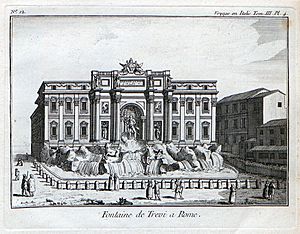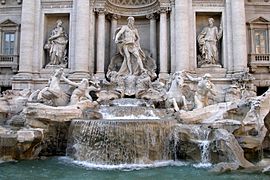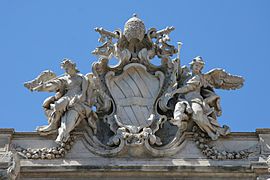Trevi Fountain facts for kids
Quick facts for kids Trevi FountainFontana di Trevi |
|
|---|---|
| Fountain | |
 |
|
| Design: | Nicola Salvi |
| Construction: | 1732–1762 |
| Height: | 26.3 metres (86 ft) |
| Length: | 49 metres (161 ft) |
| Surface: | Travertine stone |
| Location: | Rome, Italy |
The Trevi Fountain (called Fontana di Trevi in Italian) is a famous fountain in Rome, Italy. It was designed by Nicola Salvi and finished in 1762. This huge fountain is about 26 meters (86 feet) tall and 49 meters (161 feet) wide. It is the biggest Baroque fountain in Rome and one of the most well-known fountains globally.
Contents
History of the Trevi Fountain's Water Source
The Trevi Fountain is located where three roads meet (called tre vie in Italian). It marks the end point of an ancient aqueduct called the Aqua Virgo. This aqueduct brought water to ancient Rome.
Around 19 BC, Roman engineers found a source of clean water about 13 kilometers (8 miles) from the city. Legend says a young girl helped them find it. This story is shown on the fountain today. The aqueduct was about 22 kilometers (14 miles) long because of its winding path. It supplied water to the Baths of Agrippa and served Rome for over 400 years.
What Does "Trevi" Mean?
The name of the fountain, "Trevi," comes from the Latin word trivium. This word means "intersection of three streets." The fountain is right in the middle of three streets: Via De' Crocicchi, Via Poli, and Via Delle Muratte.
Ancient Roman Aqueducts
During the 6th century, the aqueducts that brought water to Rome were not kept in good condition. Many of the 14 working aqueducts were damaged when the Ostrogoths invaded.
The "virgin water" aqueduct still carries water to the Trevi Fountain today. It collects water from about 10 kilometers (6 miles) outside Rome. This aqueduct is still used, even though the fountain has been emptied sometimes for repairs.
Designing and Building the Fountain

In 1629, Pope Urban VIII thought the old fountain was not grand enough. He asked Gian Lorenzo Bernini to draw plans for a new one. But the project stopped when the Pope died. Even though Bernini's design was never built, some of his ideas can be seen in the fountain today.
Many artists created designs for the fountain. In 1730, Pope Clement XII held a contest to choose a design. Nicola Salvi first lost to Alessandro Galilei. But people in Rome were upset that a non-Roman had won, so Salvi was given the job instead. Work on the fountain began in 1732.

Salvi died in 1751, and the fountain was only half-finished. He had made sure to hide an ugly barber's sign behind a sculpted vase. Romans called this vase the asso di coppe (Ace of Cups) because it looked like a Tarot card.
Four different sculptors were hired to finish the fountain's decorations. These included Pietro Bracci, who created the large statue of Oceanus in the center. Giuseppe Pannini became the architect to complete the work.
The Trevi Fountain was finished in 1762 by Pannini. He changed some of the planned sculptures to the ones we see today. The fountain was officially opened on May 22 by Pope Clement XIII. Most of the fountain is made from Travertine stone, which comes from near Tivoli, about 35 kilometers (22 miles) east of Rome.
Keeping the Fountain Beautiful: Restoration Work
The Trevi Fountain has been cleaned and repaired several times. In 1988, it was cleaned to remove dirt from pollution. In 1998, the stone was scrubbed, and cracks were fixed by skilled workers. New pumps were also added to recirculate the water.
In 2013, a fashion company called Fendi announced they would pay for a big restoration. This project cost 2.2 million euros and was the most complete restoration in the fountain's history.
The restoration started in June 2014 and finished in November 2015. The fountain was reopened with a special ceremony on November 3, 2015. As part of the work, over 100 LED lights were installed to make the fountain look even better at night.
What the Fountain's Sculptures Mean
The fountain is built in front of the Palazzo Poli building. The building's front was changed to match the fountain's grand design. The main idea of the fountain is "taming of the waters." It shows water and rock mixing together, filling the small square.
In the center, a large arch is placed on the building's front. The main area, or niche, holds the statue of Oceanus, the god of the sea. He stands in a shell chariot guided by Tritons (half-human, half-fish creatures) who are taming hippocamps (sea horses).
On either side of Oceanus, there are two other statues. One is Abundance, who pours water from her urn. The other is Salubrity, who holds a cup from which a snake drinks. Above these, stone carvings show how the ancient Roman aqueducts were built. The Tritons and horses are balanced on each side, showing different moods and poses.
Throwing Coins into the Fountain
Many people throw coins into the Trevi Fountain. It is said that you should throw a coin with your right hand over your left shoulder. This tradition was made famous by the 1954 movie Three Coins in the Fountain.
About 3,000 euros are thrown into the fountain every day. In 2016, about 1.4 million euros (about 1.5 million US dollars) were collected. This money is used to help a supermarket for people in Rome who are poor. However, it is against the law to try and steal coins from the fountain.
Gallery
Copies of the Trevi Fountain
There are other places around the world that have copies of the Trevi Fountain.
- A similar monument, 11 meters (36 feet) high and 20.6 meters (68 feet) wide, was built in 2023 in Serra Negra, Brazil.
- Another copy is located near Caesars Palace in Las Vegas.
- You can also find a replica in the Jamsil station of the Seoul Metro Subway in South Korea.
See also
 In Spanish: Fontana di Trevi para niños
In Spanish: Fontana di Trevi para niños
- List of fountains in Rome





